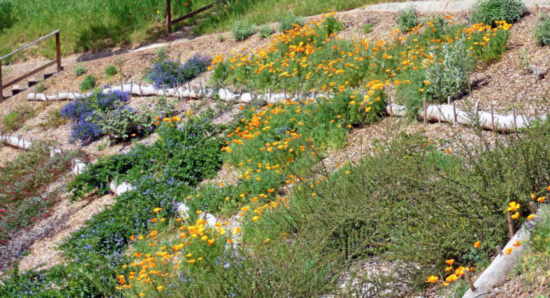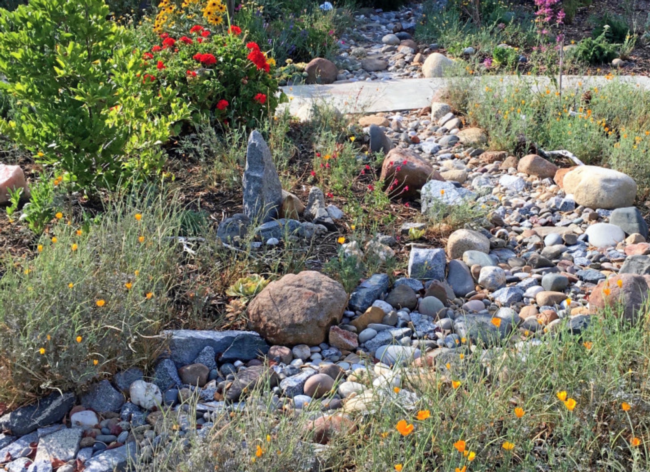Preventing Erosion
While we can’t control the rain itself, we can employ some landscaping strategies to direct the path of the water and reduce garden damage. Since erosion is a common problem in our hilly residential areas, a first defense against the destructive effects of rain runoff is to stabilize slopes. The most effective techniques for erosion control are determined by the steepness of the terrain. In its “Homeowner’s Guide to Erosion Control,” the California Natural Resources Conservation Service provides guidelines for slope stabilization based on the extent of the grade.

Moderate Slopes:
Moderate slopes, with less than a 33 percent grade, can be protected with plants and mulch. Plants selected for erosion control should have deep spreading root systems. A mix of ground covers, perennials, shrubs, and trees is ideal. Some native species that are good for slopes include eriogonum (California buckwheat), arctostaphylos (manzanita), rhamnus (coffeeberry), ceanothus (California lilac), and baccharis pilularis (coyote brush). Bare soil between the plants should be covered with a layer of organic mulch such as small bark or wood chips that are not likely to wash away easily. Avoid the finely shredded bark that is sometimes sold to cover slopes. It is a fire hazard.
Steeper Slopes:
The steeper the slope the more likely additional structural support will be needed for stabilization, Slopes with grades between 33 and 50 percent can also be planted, but erosion controls such as jute netting and straw wattles (long fiber-encased straw tubes) may be need to be installed to retain the slope until the plants can take over.
Steepest Slopes:
Slopes over 50 percent will require retaining walls or terracing for stabilization. Terraces can be an attractive option and provide more usable garden space allowing for a greater variety of plant selection. Rocks, boulders, concrete blocks and railroad ties can be used to create simple low retaining walls for hillside terracing. Taller walls may require help from a professional contractor to insure the results are stable and properly reinforced. The Marin County Building and Safety Division requires a permit for retaining walls over 4 feet in height.

Drainage Systems:
If last year’s rainfall produced a mossy bog in your garden, then consider installing a drainage system to redirect the flow of water to areas where it will not collect and cause problems. Much of the soil in Marin is fine-textured clay that drains slowly and increases the potential for surface runoff. A dry creek bed is a popular type of surface drain. Constructed with boulders and river rock to appear as a natural stream, a dry creek bed can be designed to channel water down a slope or simply to provide a trough to capture the rainfall and allow it to
soak into the ground.
Where runoff is heavier, a French drain can help. A French drain is a subsurface drain consisting of a gravel-filled trench with a perforated pipe in the bottom. The perforated pipe directs the excess water collected in the trench to a disposal site. French drains can be used to divert rainwater around houses and patios and to provide additional drainage on terraced hillsides behind retaining walls.
Additional drainage systems include berms, swales, rain gardens, wattles and water permeable surfaces. See Rain, Rain, Don’t Go Away. Also see A Guide to Straw Wattle Installation, Marin County.
Additional Information:
For further information regarding hillside gardening and understanding soil erosion, see Gardening on a Hillside, Sonoma Master Gardeners, and Understanding Soil Erosion in Irrigated Agriculture.
Original article by Marty Nelson (7/19/18) for the Marin Independent Journal
Edited for MMG public website by Susan Saltzman 10/20/2018)
Photo Credits:
Photo 1 top: Wattles on Hillside. Bob Mauceli, Marin Master Gardener
Photo 2 Bottom: Rock Stream Drainage. Lisa Martino, Marin Master Gardener
